Llano in the Wild: Toshiba's Satellite L775D-S7206
by Dustin Sklavos on August 12, 2011 12:45 AM ESTOh My Stars: Application Performance
Most of the more informed of our readers are already going to have a pretty good idea of how the CPU-based tests are going to shake down. The Stars core at the foundation of the Llano APU was mostly competitive with mainstream Intel CPUs the day it released, but it hasn't aged well, and the cripplingly low 1.4GHz nominal clock rate of the A6-3400M powering the Toshiba L775D-S7206 is going to look pretty dire on paper. What's important to keep in mind is that this processor is still fast enough for most basic tasks, though: you can still edit video and photos with it, but it's definitely going to take longer than a comparable Intel chip. There's also that potential 2.3GHz Turbo Core available; we can't measure how often the cores are actually running above 1.4GHz, but look at the results.
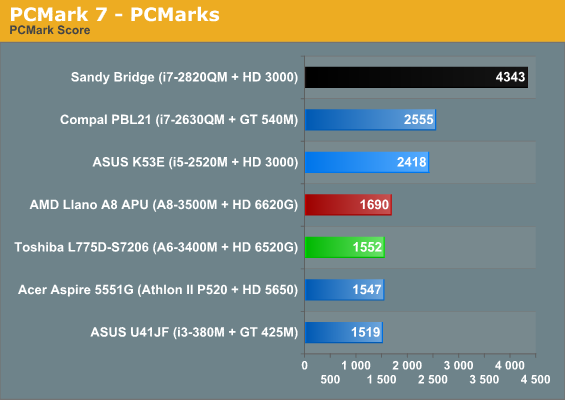
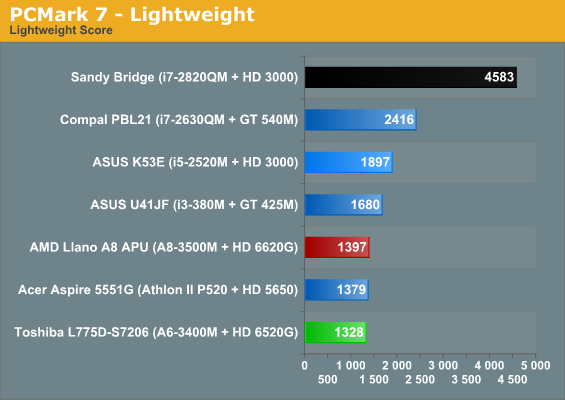
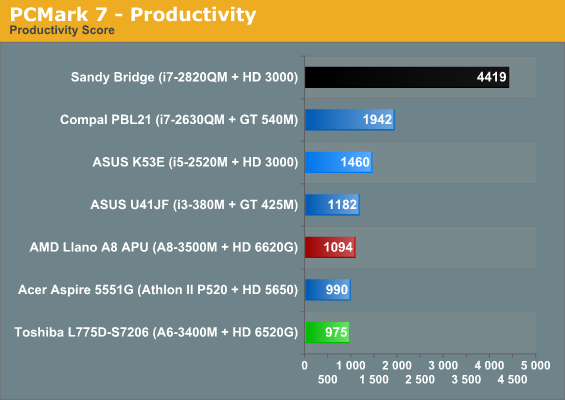
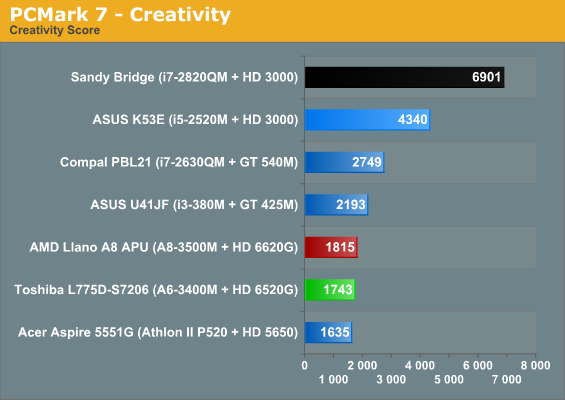
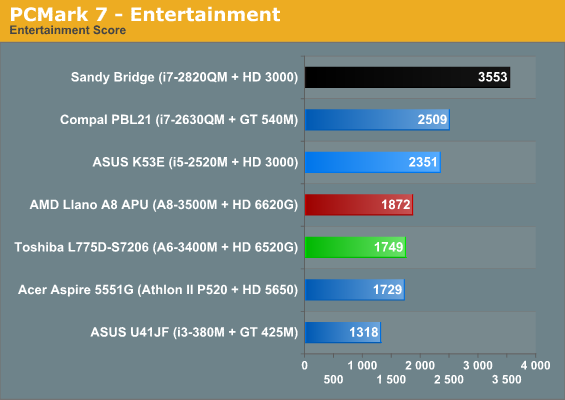

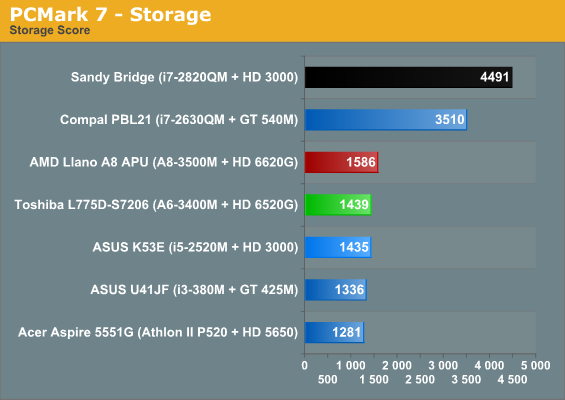
You can see in PCMark 7 that Sandy Bridge pretty much dusts the A6-3400M (noting that the quad-core Sandy Bridge test systems do benefit from SSDs), and it basically trades blows with Arrandale. The dual-core i5-2520M with an HDD is in the ASUS K53E, and outside of the storage test it also pummels Llano. What's particularly interesting, though, is that the A6-3400M is barely slower than the A8-3500M, at least in these synthetic tests. That makes sense: only 100MHz separates the two processors, but at least as far as the CPU goes you can make that sacrifice fairly comfortably since the A8 is much more rarefied in the wild than the A6. The Athlon II P520, meanwhile, boasts two cores at a nominal 2.3GHz and trades blows with the new Llano chips.

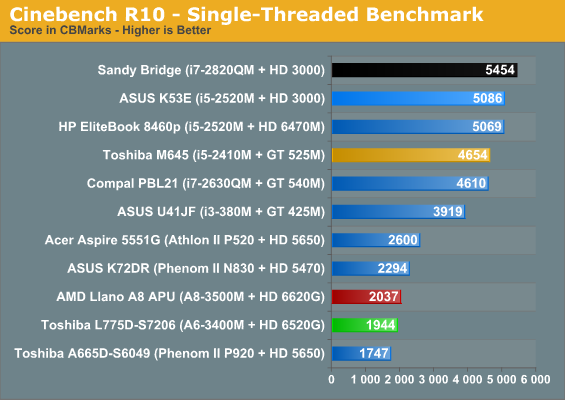
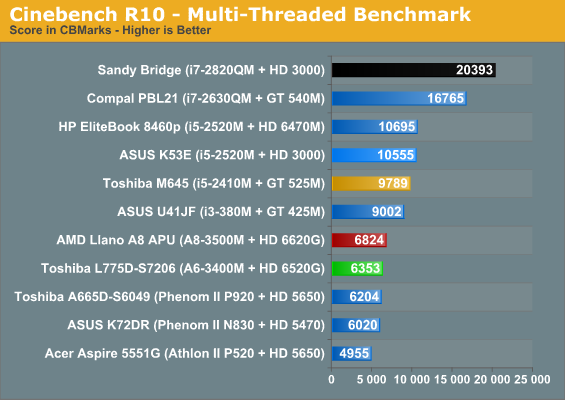
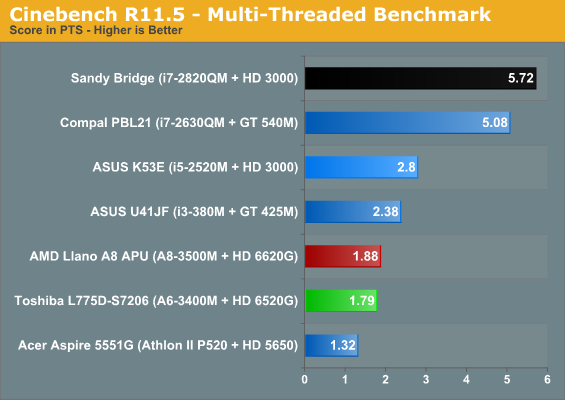
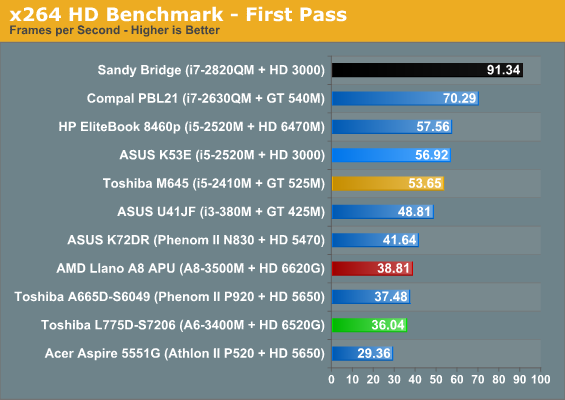
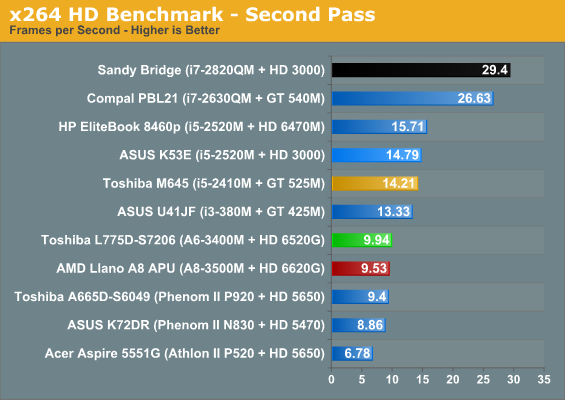
There's an awful lot to digest here. First, two of Intel's Hyper-Threaded cores running at a high clock speed basically run roughshod over four slow Stars cores: no surprsies there. But the Phenom II P920 in the Toshiba A665D-S6049 is a 1.5GHz quad core with 512KB of L2 cache per core instead of 1MB as in Llano, though the cores are otherwise almost identical. In most cases the AMD chips bunch together while the Intel chips gum up the top of the chart. The takeaway is brutal, though: Trinity, with its Bulldozer cores instead of Stars cores, can't get here fast enough. The i7-2820QM in our Sandy Bridge testbed is nearly three times faster than Llano, and the i5-2520M is about 60% faster on average.


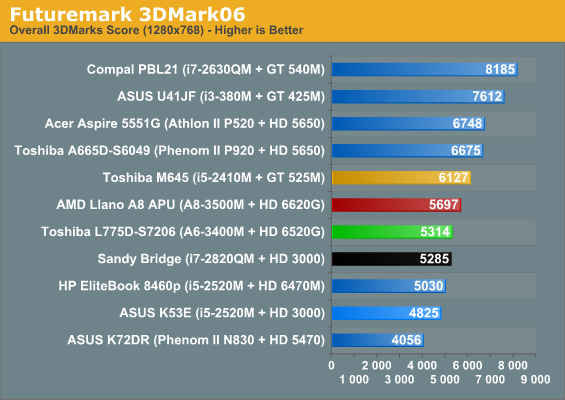
Things brighten up a bit when we get to 3DMark, where Llano's modified Redwood GPU core is able to hang fairly well with discrete-class GPUs. The A6-3400M may be closer to the bottom of the charts in each case, but it's still producing impressive performance compared to the string of dedicated graphics parts. It's easy to understand why AMD's PR splits hairs about calling Llano's graphics core an IGP and prefer to call it an "iGPU" or Fusion GPU, because while it's an IGP in the strictest sense, it doesn't necessarily deserve the negative connotations that have stigmatized the term as a result of Intel's pre-Sandy Bridge integrated graphics parts. Also worth pointing out in case you missed it is the lack of 3DMark11 results for any of the Intel IGPs; as a test that requires DX11, even Sandy Bridge can't run it without a dedicated GPU.










74 Comments
View All Comments
Crazymech - Friday, August 12, 2011 - link
Gotta agree with Dustin here.Tho I would like to add that I'm begining to think the problem is that the UI elements of windows aren't really being designed with this resolution in mind. I think Microsoft should start setting a 1920x1xx0 baseline resolution for designing the next UI, so that things wont be too small at our current standard.
This would allow us to enjoy the higher PPI without straining our eyes to see the tiny details. Like iPhones 4's screen for example. Icon size just the same, just more PPI - lovely to look at.
kmmatney - Friday, August 12, 2011 - link
I have crappy eyes, and a 17" laptop with 1920 x 1200 resolution. I normally run the screen at 1440 x 900, which looks great. I like the fact that I can go to 1920 x 1200 when I really need the extra real-estate, but i can't handle that resolution very long. it nice to have the option, though.seapeople - Friday, August 12, 2011 - link
I have really crappy eyes too, but I went to this thing they call an eye doctor (i.e. Walmart) and now while wearing these special lens type things I can actually see far away things just like I could when I was younger. I didn't realize this was an uncommon thing?Dustin Sklavos - Friday, August 12, 2011 - link
The sarcasm is amusing but not entirely appropriate. Some of us with eye problems have a harder time getting them corrected as exactly. Despite my horrifically strong scrip and regular visits to the eye doctor, I still have trouble focusing sometimes.frozentundra123456 - Saturday, August 13, 2011 - link
Good comment Dustin. I still have decent vision, but I have had some problems that are not correctable that have decreased my vision somewhat. Believe me, it is really frightening to think that you might be losing vision in one or both eyes. Fortunately, the problem was not as serious as I first thought.However, I do know others that have very serious vision problems that are not totally fixable after many thousands of dollars of expensive surgery, much less a trip to Walmart. So I agree that seapeople's comment, intentionally or not, was not appropriate and is offensive to those who have serious vision problems.
joe_dude - Friday, August 12, 2011 - link
IMHO, the NV75 is much better deal than the Toshiba. It comes with A8-3500m + dGPU. In Canada, it's $700 fully loaded with Blu-Ray.I think the A6 is better for low-end 13" to 15" laptops, where Intel + dGPU has a tendency to overheat (e.g. Acer TimelineX) or sounds like a jet engine in games.
Also, the productivity benchmarks are very misleading. On the NV75 (and I assume the Toshiba as well), the system is very responsive for day-to-day use. The CPU is definitely NOT a bottleneck.
Dustin Sklavos - Friday, August 12, 2011 - link
The Gateway NV75, at least the models I've seen, does not include a dGPU. Any Radeon HD with the letter "G" at the end of the model number refers to the graphics built into the Llano APU. That said, you're right, the NV75 does look like a better deal.joe_dude - Friday, August 12, 2011 - link
The Canadian model has a 6650m with 1 GB of VRAM.http://www.futureshop.ca/en-CA/product/gateway-gat...
The smallest AMD A6 laptop I can find so far is the 14" HP G4. Wanna review that one too? :>
charliek45 - Friday, August 12, 2011 - link
Hi Dustin,Would you be able to expand on the heat and noise section of this review? I own an old Asus laptop and it gets very hot and noisy while playing games, sometimes to the point of shutting down, so this is one of the most important criteria for me when selecting a laptop. Can you please compare the heat and noise under load to other laptops? In particular, I am interested to know whether Llano is able to run cooler than Intel + dedicated graphics cards when playing games and if so, how much cooler.
MrCromulent - Friday, August 12, 2011 - link
10/100 Ethernet... are you serious, Toshiba?Even for low-end machines that's unacceptable in this day and age.